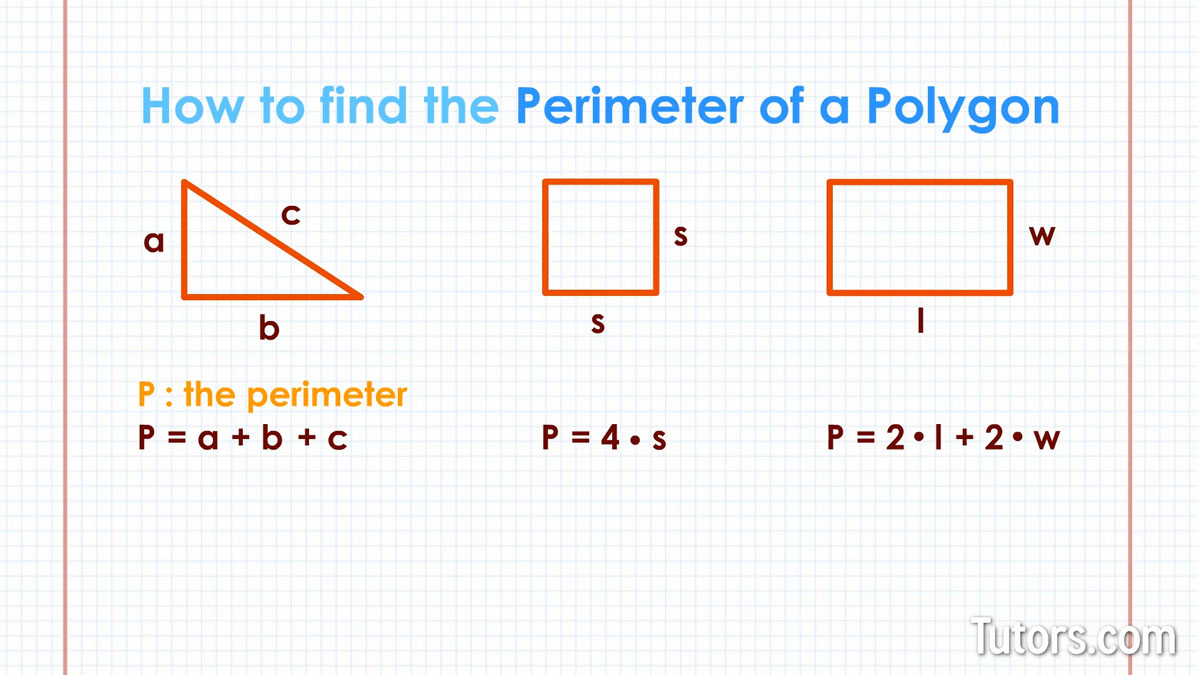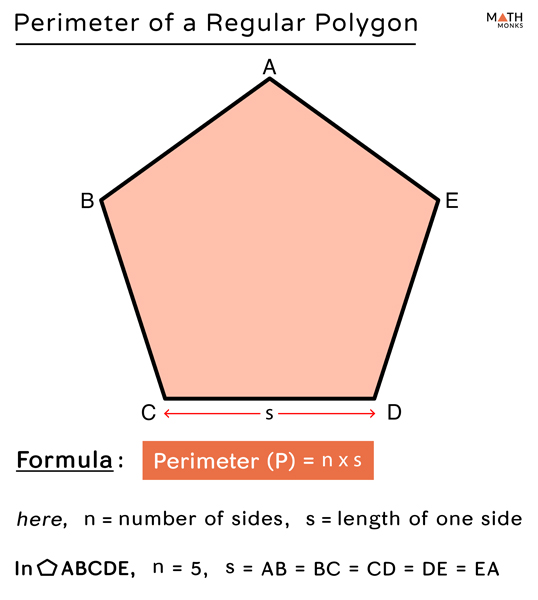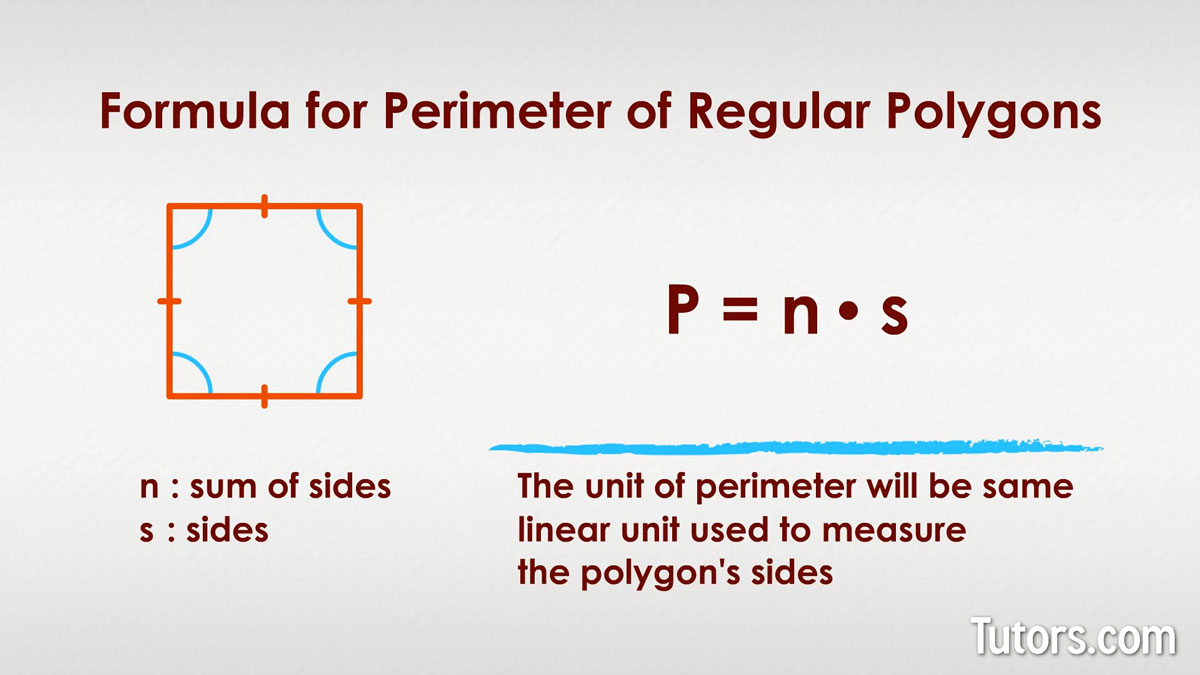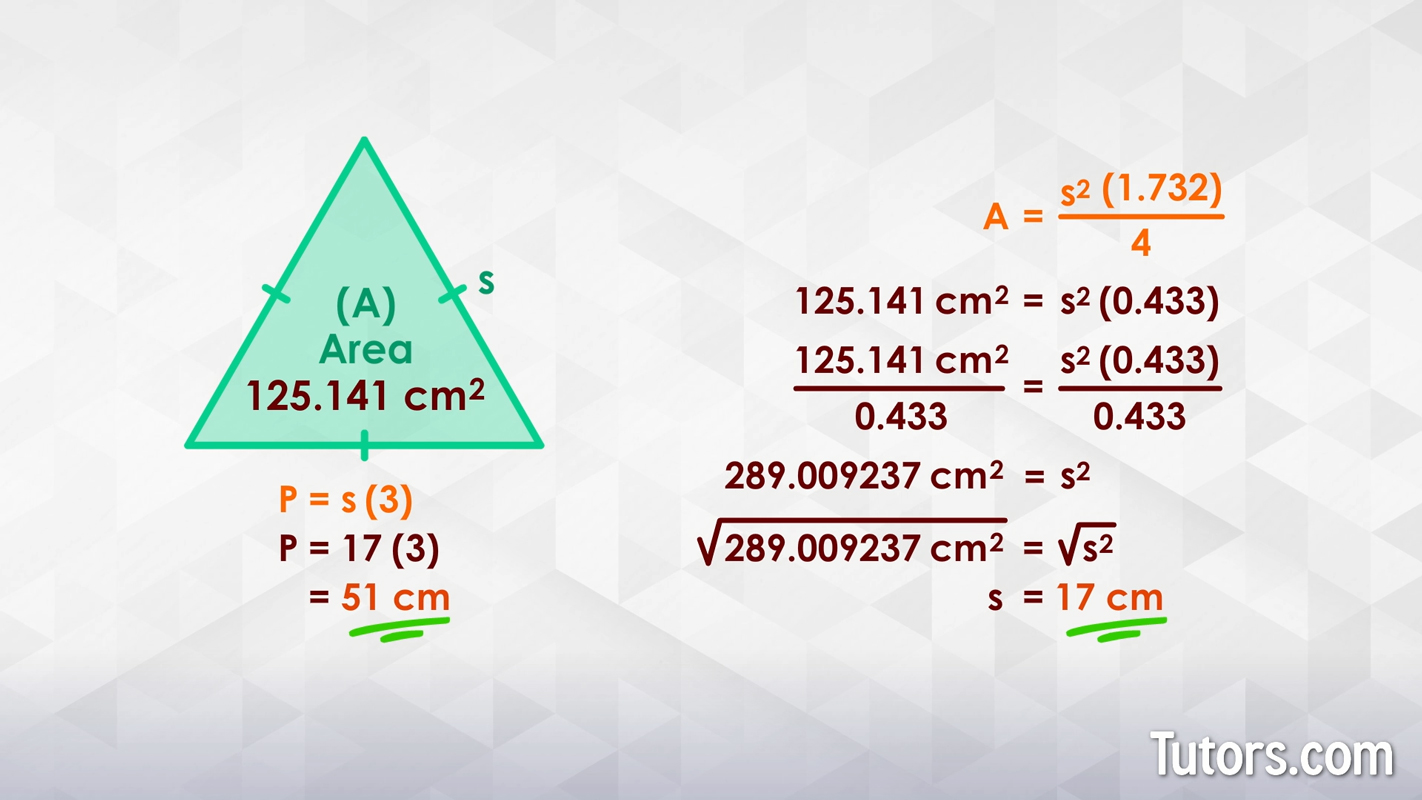Topic how to find perimeter of polygon: Discover the secrets of geometry with our in-depth guide on "How to Find Perimeter of Polygon", simplifying complex concepts into easy-to-understand steps for enthusiasts and learners alike!
Table of Content
- Understanding the Perimeter of a Polygon
- Formulas for Regular Polygons
- YOUTUBE: Calculating the Perimeter of Polygons
- Calculating Perimeter of Irregular Polygons
- Examples of Perimeter Calculations for Common Polygons
- Perimeter Calculation for Polygons on Coordinate Planes
- Methods to Determine Missing Side Lengths in Polygons
- Special Cases: Perimeter of Circles and Other Shapes
- Practical Exercises and Problems for Learning
Understanding the Perimeter of a Polygon
The perimeter of a polygon refers to the total length of its outer boundaries. It can be calculated differently based on whether the polygon is regular (all sides and angles are equal) or irregular (sides and angles vary).
Regular Polygons
For regular polygons, where all sides are of equal length, the perimeter is simply the product of the number of sides and the length of one side. The formula is:
Perimeter = Number of sides × Length of one side
Irregular Polygons
In the case of irregular polygons, the perimeter is found by summing the lengths of all its sides.
For example, if a quadrilateral has sides of lengths 7 feet, 9 feet, 6 feet, and 5 feet, its perimeter would be calculated as:
Perimeter = 7 feet + 9 feet + 6 feet + 5 feet = 27 feet
Using Coordinates
When dealing with polygons on coordinate planes, the perimeter can be determined using the distance formula between each set of vertices. After calculating the lengths of all sides, these lengths are then summed to find the perimeter.
Important Formulas
- Rectangle: Perimeter = 2 × (Length + Breadth)
- Parallelogram: Perimeter = 2 × (Sum of parallel sides)
- Rhombus: Perimeter = 4 × (Length of one side)
Understanding these concepts is crucial in geometry and practical applications such as construction and design.

READ MORE:
Formulas for Regular Polygons
Calculating the perimeter of regular polygons is straightforward due to the uniformity in their side lengths. The perimeter of a regular polygon is the total distance around its boundary, and can be calculated by multiplying the length of one side (s) by the number of sides (n).
The formula for the perimeter of a regular polygon is:
Perimeter (P) = n × s
Where n is the number of sides and s is the length of one side.
Examples:
- A regular hexagon (6 sides) with each side measuring 4.5 meters will have a perimeter of:
- P = 6 × 4.5 = 27 meters.
- A square (4 sides), each side measuring 12 cm, will have a perimeter of:
- P = 4 × 12 = 48 cm.
It\"s important to note that for regular polygons, the perimeter is directly proportional to the side length. This means that doubling the length of a side will double the perimeter of the polygon.

Calculating the Perimeter of Polygons
\"Learn how to easily calculate the perimeter of any shape in this informative video! Discover useful tips and techniques that will make finding the perimeter a breeze. Watch now and become a pro at measuring the boundaries of objects!\"
How to Calculate the Perimeter of Polygons
\"Unlock the secrets of effortless calculations with this captivating video! From basic arithmetic to complex formulas, you\'ll gain a deep understanding of how to calculate various quantities. Join us on this mathematical journey and sharpen your calculation skills today!\"
Calculating Perimeter of Irregular Polygons
Calculating the perimeter of an irregular polygon requires a different approach compared to regular polygons. Since the sides of an irregular polygon are not equal, the perimeter is determined by summing the lengths of all its sides.
The formula for the perimeter of an irregular polygon is:
Perimeter (P) = Sum of the lengths of all sides
Steps for Calculation:
- Measure the length of each side of the polygon.
- Add the lengths of all the sides to get the total perimeter.
Example:
- For a quadrilateral with sides of 7 feet, 9 feet, 6 feet, and 5 feet, the perimeter would be:
- P = 7 + 9 + 6 + 5 = 27 feet.
- In a polygon with sides measuring 6 cm, 9 cm, 10 cm, and 5 cm, the perimeter is:
- P = 6 + 9 + 10 + 5 = 30 cm.
It\"s important to note that for irregular polygons, the perimeter is not directly proportional to the side lengths as in regular polygons. The total perimeter depends on the individual lengths of all sides.

Examples of Perimeter Calculations for Common Polygons
Perimeter calculations for various polygons can differ depending on the type and dimensions of the polygon. Below are some examples to illustrate how to calculate the perimeter for common polygons.
Regular Polygons
- Equilateral Triangle: For a triangle with each side measuring 9 units, the perimeter is calculated as 3 times the side length, giving a perimeter of 27 units.
- Regular Hexagon: If each side of a hexagon is 18 feet, the perimeter is calculated as 6 times the side length, resulting in a perimeter of 108 feet.
Irregular Polygons
- Quadrilateral: A quadrilateral with sides measuring 7, 9, 6, and 5 feet would have a perimeter of 27 feet, calculated by adding all four side lengths.
- Complex Polygon: In a complex case where the polygon has unknown side lengths, the perimeter can be calculated by solving an equation that sums the known side lengths and equates them to the total perimeter. For example, if a polygon has known side lengths of 3, 4, 6, 2, and 1.5 units and an unknown side x, with a total perimeter of 18.5 units, the missing length can be found by solving for x in the equation 3 + 4 + 6 + 2 + 1.5 + x = 18.5.
Using Coordinates
For polygons defined by coordinates, such as a shape with vertices at A(0, 0), B(0, 4), C(4, 4), and D(4, 0), the perimeter can be determined by calculating the distances between each pair of adjacent vertices using the distance formula and then summing these distances.

Perimeter Calculation for Polygons on Coordinate Planes
Calculating the perimeter of polygons on coordinate planes involves a systematic approach to determine the total length of the polygon\"s boundaries. This method is particularly useful for irregular polygons whose side lengths are not readily apparent.
- Determine the Coordinates of Each Vertex: Start by identifying the coordinates of each vertex of the polygon on the coordinate plane.
- Calculate the Distance Between Consecutive Vertices: Using the distance formula (sqrt{( ext{x}_2 - ext{x}_1)^2 + ( ext{y}_2 - ext{y}_1)^2}), calculate the length of each side of the polygon by considering the coordinates of consecutive vertices.
- Sum up the Lengths: Add the lengths of all sides to find the total perimeter of the polygon.
Example:
Consider a polygon with vertices at (0,0), (0,3), (3,3), and (3,0). We calculate each side as follows:
- Length of AB = (sqrt{(0 - 0)^2 + (3 - 0)^2}) = 3 units.
- Length of BC = (sqrt{(3 - 0)^2 + (3 - 3)^2}) = 3 units.
- Length of CD = (sqrt{(3 - 3)^2 + (3 - 0)^2}) = 3 units.
- Length of DA = (sqrt{(0 - 3)^2 + (0 - 0)^2}) = 3 units.
Adding these together, the perimeter of the square is 12 units.
Special Cases:
In cases where the polygon is regular (all sides and angles are equal), the perimeter can be calculated simply as the number of sides multiplied by the length of one side.
For irregular polygons, each side length must be calculated individually using the distance formula and then summed to find the perimeter.
It\"s important to ensure that all calculations are done in the same unit for consistency.

_HOOK_
Methods to Determine Missing Side Lengths in Polygons
Finding missing side lengths in polygons is a crucial skill in geometry. This process varies depending on whether the polygon is regular or irregular, and on the available information about the polygon\"s sides and angles. Here we outline various methods to determine these missing lengths.
For Regular Polygons
- Use the Perimeter: If the perimeter and the number of sides are known, divide the perimeter by the number of sides to find the length of each side.
For Irregular Polygons
- Using Triangle Laws: In cases where a polygon can be divided into triangles, apply the sine or cosine rules to find the missing lengths.
- Perimeter Information: If the perimeter of the polygon and the lengths of other sides are known, subtract the sum of the known side lengths from the total perimeter to find the missing side.
- Angle Properties: Utilize properties of angles (such as alternate angles, angles on a straight line, or interior angles) to deduce side lengths. This method often involves additional geometric concepts like the Pythagorean theorem.
Examples
- Example for a Regular Polygon: In a hexagon with a known perimeter of 30 cm, each side can be calculated as 30 cm / 6 = 5 cm.
- Example for an Irregular Polygon: For a quadrilateral with sides of lengths 8 m, 6 m, and 10 m, and a known perimeter of 31 m, the missing side can be calculated as 31 m - (8 m + 6 m + 10 m) = 7 m.
These methods are applicable in various scenarios and require an understanding of basic geometric principles. Practice and familiarity with different types of polygons will enhance your ability to determine missing side lengths effectively.

Special Cases: Perimeter of Circles and Other Shapes
While polygons are shapes with straight sides, there are also special cases involving shapes with curved sides. The most common of these is the circle, but there are others like ellipses and ovals. The method for calculating the perimeter (or circumference in the case of a circle) of these shapes differs from that of polygons.
Perimeter of a Circle (Circumference)
The perimeter of a circle, commonly referred to as the circumference, is calculated using the formula ( C = 2 pi r ), where ( r ) is the radius of the circle, and ( pi ) is approximately 3.14159.
Perimeter of an Ellipse
Calculating the exact perimeter of an ellipse is complex, involving integral calculus. However, an approximate formula is ( P approx pi sqrt{2(a^2 + b^2)} ), where ( a ) and ( b ) are the semi-major and semi-minor axes of the ellipse, respectively.
Perimeter of an Oval
An oval, or an elongated circle, has a perimeter that can be approximated by various formulas, one of which is ( P approx pi [ 3(a + b) - sqrt{(3a + b)(a + 3b)} ] ), where ( a ) and ( b ) are the lengths of the semi-major and semi-minor axes.
These special cases require different approaches than polygons due to their curved sides. While exact calculations can be complex, approximate formulas provide a good estimation of their perimeters.

Practical Exercises and Problems for Learning
Understanding the perimeter of polygons is crucial for students of geometry. The following practical exercises and problems are designed to enhance your understanding and application of the concepts related to finding the perimeter of polygons.
- Exercise 1: Calculating the Perimeter of an Irregular Polygon
- Given an irregular polygon ABCDEF with side lengths: AB = 3 units, BC = 4 units, CD = 6 units, DE = 2 units, EF = 1.5 units, and FA = x units. If the perimeter of the polygon is 18.5 units, find the value of x.
- Hint: Use the formula for the perimeter of irregular polygons, which is the sum of all side lengths.
- Exercise 2: Determining Side Length of an Equilateral Triangle
- If an equilateral triangle has a perimeter of 27 units, calculate the length of each side.
- Hint: Remember that all sides of an equilateral triangle are equal.
- Exercise 3: Perimeter of a Regular Polygon
- Find the perimeter of a regular nonagon (9-sided polygon) where each side measures 8 feet.
- Hint: The perimeter of a regular polygon is the product of the number of sides and the length of one side.
- Exercise 4: Finding Missing Length in a Polygon
- For a polygon ABCDEFGH, given AB = 5 units, BC = 9 units, CD = x units, DE = 3 units, EF = 3 units, FG = 2 units, GH = 2 units, AH = 4 units, and the perimeter of the polygon is 34 units. Find the value of x.
- Hint: Add up the known lengths and subtract from the total perimeter to find the missing length.
- Exercise 5: Square Perimeter from Area
- Given that the area of a square is 49 square inches, determine the perimeter of the square.
- Hint: First, find the length of one side of the square using the area, and then calculate the perimeter.
- Exercise 6: Perimeter of a Polygon with Coordinates
- Determine the perimeter of a polygon with vertices at A(2, 5), B(8, 5), C(8, 3), and D(2, 3).
- Hint: Use the distance formula to calculate the lengths of the sides and then sum them up.
These exercises cover various aspects of perimeter calculations, including irregular polygons, regular polygons, and polygons in a coordinate plane. Solving these will provide a comprehensive understanding of the perimeter of polygons.
Mastering the art of calculating the perimeter of polygons opens a world of geometric understanding. Our guide offers in-depth insights and practical exercises to make this journey engaging and enlightening. Dive in and discover the simplicity and beauty of geometry!





